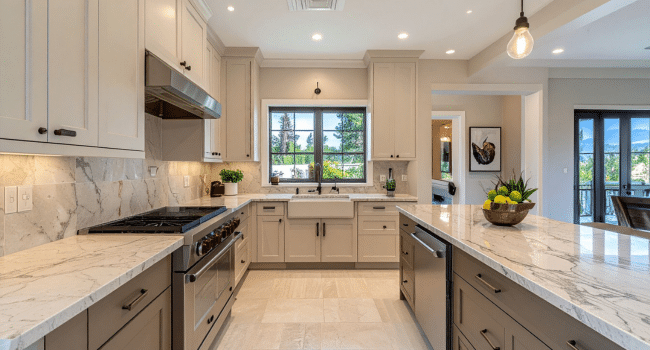Table of Contents
Kitchen cabinets often set the tone for how the entire space feels. They guide the overall style and help shape the atmosphere that people experience when they enter the room. The way cabinets look, how they open, and the materials used all work together to create a sense of order and comfort. Cabinets act as a strong visual anchor in the kitchen, making them one of the most important elements in both design and daily use.
Set the Kitchen’s Tone
Every activity in the cooking area becomes a backdrop to the kitchen cabinets. They add color and texture, affecting the way light passes through that space and making it feel warm or cool. Lighter hues are also bringing in a level of peace, while deeper, more dramatic hues will create a more sophisticated look/feel. Hardware selections, such as handles and hinges, are also part of the cabinet’s character and, by extension, the kitchen’s overall look.
Creating Visual Continuity
The configuration and type of cabinetry create an impression of continuity between spaces. Cohesive designs can help unify open-concept homes, connecting the kitchen with nearby living or dining spaces. As a separate zone, the kitchen can feel distinct from the rest of the house, so matching finishes and coordinating materials help keep it more cohesive. This harmony enables smaller homes to appear larger and more cohesive.
Expressing Personal Style
One of the best ways to showcase personal taste is through cabinets. From traditional detailing to sleek minimalism, cabinetry can serve as a canvas for expression. Choose accent features wisely. You can do with glass panels, open shelving, and intricate carvings to offer personality accessories without overwhelming the space. New cabinet hardware, repainting doors, or combining various wood types can easily transform the look of a kitchen.
Impact on Perceived Space
Generally, well-purposed cabinets can create the illusion of a larger or smaller kitchen. Light-colored paint usually instantly gives rooms a more expansive and brighter feel, and dark tones can provide warmth. Vertical cabinets will draw the eye up, adding height, while a horizontal arrangement may create greater width. Properly positioned cabinetry can disguise mess, making the kitchen appear larger and tidier.
Highlighting Function and Organization
Cabinets aren’t just about looks, after all—they are a key component of a functional kitchen. Smart storage strategies, including pull-out trays and deeper drawers, ensure that essentials are easily accessible at your fingertips. Utilizing corners and vertical space wisely guarantees the efficient use of every inch. An organized and clean kitchen brings a sense of comfort and functionality, and the kitchen cabinets, placed beautifully in an arranged fashion, lend to the feeling of everything being in its place.
Influence on Home Value
People often concentrate on kitchens when buying property. Stylish, well-maintained cabinets can elevate the look of a house and increase its value. Old or damaged cabinetry, on the other hand, can have the opposite effect, making an entire kitchen feel dated. Consumers are more likely to buy cabinets that have a great look, but also expect the durability that comes with such craftsmanship. This advantage provides a sustainable quality payoff if you invest money up front in high-quality materials.
Blending with Other Design Elements
Cabinets need to match countertops, backsplashes, and appliances. Nail that combination and you have a perfect harmony, where no one ingredient drowns out the entire room. Add interest by mixing materials, for example, by combining wood and glass or metal. Like the shades for walls and flooring, the colors must blend with all areas of the kitchen’s design.
Emphasizing Sustainability and Quality
The materials we use in our cabinetry say something about our values and our priorities. As a result, most homeowners are demanding greener options, such as certified woods or recycled materials. Cabinets now have durable finishes and are built with sturdier components, ensuring they last long enough that we won’t need to replace them as often. Making better decisions about materials and assembly methods leads to a more sustainable and humane home.
Conclusion
Complex kitchen cabinets do not just house dishes and cookware. Those design decisions establish ambiance, impact the organization, and even reflect the homeowner’s distinct taste. However, practical kitchens can be created by selecting cabinets that complement other design elements.
Carefully crafted cabinets enhance the kitchen’s permanence, making it easier to enjoy a beautiful day. Then, cabinets are always the center of attention in every home, so make a thoughtful choice of style and material that suits both your personality and practical needs.
